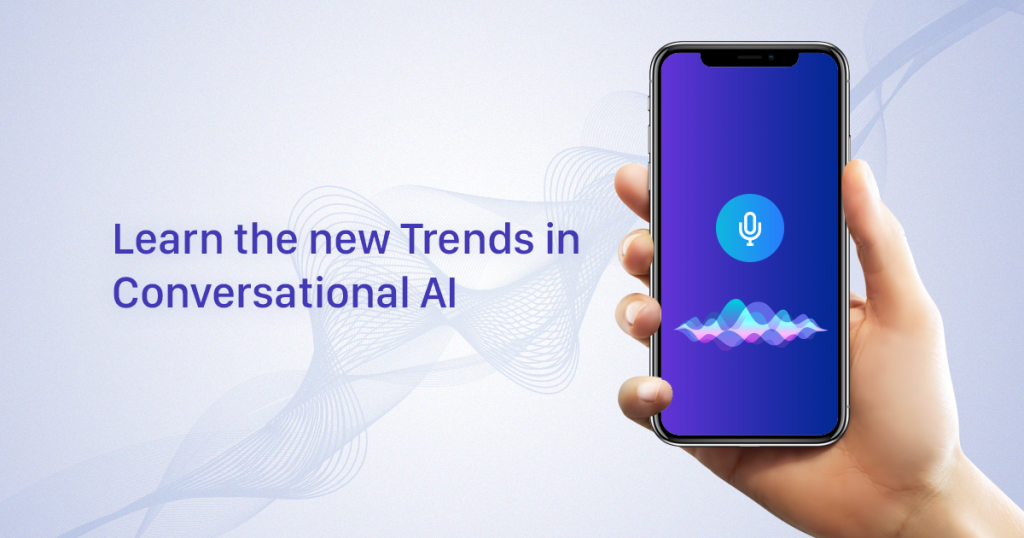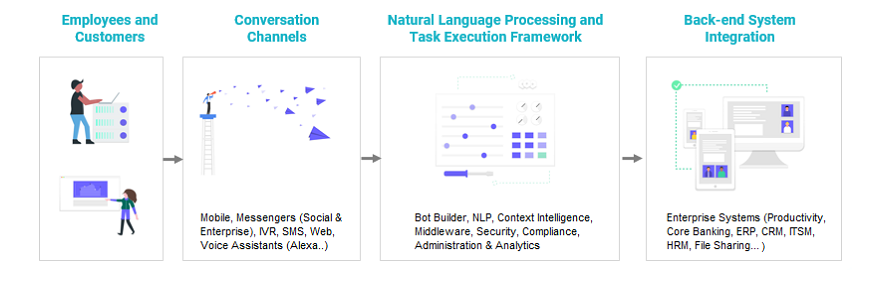With technology gaining its pace in the business world, AI in the form of conversational chatbots and virtual assistants interact with humans via voice or text commands on devices like smartphones, infotainment consoles, and smart speakers. Conversing with AI has become routine for consumers and soon it will be for employees too. In the work front, conversational AI helps employees interact more seamlessly with each other, streamline internal operations, execute the internal process, and deliver information more efficiently.

Further insights on:
- Where and why to use conversational AI
- Artificial Intelligence Goals
- How to drive enterprise adoption of conversational AI
- How to grow conversational agent capabilities as technology evolves
Increase Business Productivity
In the past, an employee with a question about how to get something done would ask a knowledgeable colleague for an answer. Now they’ll likely ask a conversational AI, and artificial intelligence (AI) to answer their questions.
AI is racing out of the developers’ room and onto the front lines of business, driving enterprises around the globe to transform the way they operate. AI has become essential to competing in today’s market—for predicting what customers want and discovering how to serve them with more rewarding and personalized experiences.
Conversational Agents: Where and Why
With increased attention of conversational agents, leading companies are gearing up deploying AI to streamline and enhance organizational operations. Automation has been a lever for business process improvement for some time, but the advent of conversational AI now makes automation accessible to individuals in their day to day work.
Here are a few significant benefits that a Conversational AI provides:
Team Assistance:
The conversational AI is trained to observe, record team interactions and accumulate important institutional knowledge. For example, conversational AI on platforms like Slack, known as “Slackbots,” are widely in use as office assistants to assign tasks, schedule meetings, translating text, and ordering food.
Streamline internal operations:
A task-oriented conversational AI can enable self-service of tedium administrative tasks, alleviating basic works. A classic example is the IT helpdesk bot, which leads employees through common multistep procedures, such as password resets, without human intervention. The sophisticated, smart and intelligent assistants allow users to book conferences rooms for meetings, guide employees on web searches and etc
Deliver Data/Information:
This type of conversational AI provides on-demand information and guidance on matters important to the team. The bot eases the pain of scaling response teams to address increased needs for company data.
Goals of Conversational AI
The goal of a conversational AI is to create a system that can learn and converse like a human.
Driving enterprise adoption of conversational agents
To keep pace with AI market leaders, enterprise conversational agent adopters should take a page from their book. Below are a few capabilities that stand out as foundational to all conversational AI deployed in the workplace:
- Conversational AI should be trained
- Conversational AI must be personalized and provide assistance that not only meets employee needs but also meets them in a familiar way.
- Conversational AI must prioritize customer/user experience.
These aforementioned capabilities help ensure that the conversational AI finds adoption within the organization and sustainably delivers a return on the investment put into its development.
Developing building blocks of successful conversational AI deployment
To ensure conversational AI deployed in the workplace deliver value and can be sustained, organizations must master the key areas: technology strategy, organizational capabilities, and organizational culture.
Technology strategy
Deploying conversational AI requires a clear understanding of the technology underpinning the bot interface, task fulfillment, and Knowledge Graph.
- Bot interface: The bot interface defines how employees interact with the conversational AI and are the key driver for fostering adoption. Usability and user experience should be assessed, defined, and validated as early as possible in the development process.
- Task fulfillment: Task fulfillment is how the bot interlinks with other systems to initiate processes by collecting the information.
- Knowledge Graph: As the conversational AI learns and adapts, the organization must curate and organize the data it is trained on, the responses it provides, and how its persona is tuned.
Organizational capabilities
‘By 2021, conversational AI-first will be adopted by the majority of enterprise IT organizations as the most important new platform paradigm’-Gartner.
Analysts forecast that conversational AI will disrupt how organizations work as well as the kinds of work people do on the job. Offerings in the technology marketplace have already started to examine how conversational AI can improve business functions ranging from sales, recruitment to scheduling meetings and planning resources. Kore believes in the range of solutions accessible by conversational interfaces will only continue to grow across the array of enterprise functions and verticals. Organizations will need to onboard new skill sets to support the deployment of conversational AI. Let’s examine some of the specific roles both technical and nontechnical people will play—and skillsets needed—to enable enterprise adoption of conversational AI:
1. Build a Conversational Roadmap
?Create a conversational vision, strategy, and product roadmap and consider whether you plan to buy, build, or take a hybrid approach.
2. Plan for the Right Skills Mix
You’ll need to obtain the right skills for your team while balancing budgets, source the best talent, and develop a culture that will retain your team and keep them efficient and productive.
3. Match Hires to Priorities
You’ll need product management, design, and engineering for any project, but it’s possible to make headway using more generally trained resources that are willing to come up to speed on basic conversational AI best practices.
Organizational culture
Bringing on AI-empowered employees is a major change for any workplace. There is always a strained environment where there are people who think technology can’t get the job done and those who worry it will take over their roles. So, it is essential to create a culture where conversational AI can flourish alongside live employees.
An advanced approach to deploying conversational AI at work
This approach has helped numerous organizations–from major retail banks, retailers, healthcare payers, insurance and investment firms–successfully leverage conversational agents to improve internal operations and deliver information and data more efficiently and effectively.
1. The Platform Components
End to end platform to build, train, analyze and manage enterprise-ready bots. The following block diagram illustrates the major features of the platform.

2. Proprietary Multi-Pronged NLP Approach
It allows you to create smart, intelligent bots that understand human intent, handle complex back-and-forth conversations, and that can complete tasks successfully.
3. GUI-Based Dialog Builder and Task Execution Framework
Kore.ai provides a visual dialog builder that helps you easily design conversation paths and create conditional nodes to handle multiple intents, sub-intents, ‘pause and resume’ scenarios. It also allows you to set up connections with external systems for a seamless data exchange.
4. Bot Training for Business Readiness
Define user utterances, synonyms, and patterns to train your model for intent detection. Manage your model using NLP thresholds that best suit your unique bot use case.
5. Omnichannel Presence
Communicate with your bot in the conversational channel of your choice. The omnichannel capability of the platform makes it available on 30+ enterprise(including voice assistants, websites and mobile apps), social, live chat, SMS, and email communication channels.
6. Bot Analytics and Dashboard
Better understand how users interact with your bots and see how well your bots perform by tracking bot engagement, conversational analytics, and functional analytics from a centralized dashboard.
7. Bot and User Administration
Manage all your bots and users from a single, comprehensive web application.
8. Multi-Layered Security and Compliance
A safe place for you to build, deploy, and manage chatbots and virtual assistants, with rigorous security standards and practices, rock-solid encryption, and built-in enterprise-class security and compliance across all components, layers, and interactions.
